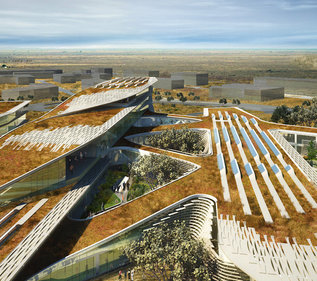2. The combination of growing domestic demand and adverse climate conditions, exacerbated in recent years by global warming, a phenomenon that has adversely affected our sub-region; Southern Africa, which means that we are likely to continue to face this challenge for some time, especially in the southern part of our country, if it does not rain. We can build dams as we have done, drill and equip boreholes, as we have done, we can lay pipelines to carry water all over as we have done and continue to do, but if it does not rain, we will always be challenged. The rain is not brought by Government, but Government if it rains, will harvest and take water to the people.
3.Fortunately, your Government has been neither blind nor complacent about this emerging trend. It was in anticipation of future challenges that the National Water Master Plan (NWMP) was finalised back in 1990 as a long term roadmap for the management as well as supply of water resources nationwide. (Gaborone Dam and expansions such as the Bokaa, Molatedi, North-South Carrier 1, Dams construction, North-South Carrier 2, Wellfields, Chobe-Zambezi, Lesotho)
4. A core focus of the plan has been and remains the development of water resources to serve the population concentrated along the eastern corridor of our country.
5. Delivery of this Master Plan began back in 1992 through the implementation of the Phase 1 of the North South Carrier Scheme or NSC 1, which included the construction of Letsibogo dam linked by a 360 km water pipeline to the Mmamashia waterworks with associated infrastructure in Mahalapye and Palapye, as well as Mmamashia.
6. The purpose of NSC 1 was to supply portable water to Palapye, Mahalapye and the Greater Gaborone area, with communities such as Molepolole, Thamaga, Moshupa, Kanye and the Goodhope Sub-District ear marked for connection in subsequent phases of the scheme.
7. Given its ambitious scope of the Master Plan in the light of projected needs, its implementation has been carried out in phases. Yet, notwithstanding competing national demands implementation of the plan has been and shall remain a national priority. In this respect, we are all certainly indebted to its initiators for their foresight.
8. Changes in the environment have, moreover, meant that we have had to further accelerate our efforts to ensure that our water stressed regions are catered for. In 2006 a revised action plan was developed, based on an integrated approach to achieving water security by tapping into groundwater supplies and promoting conservation, as well as the further construction of dams and expanded pipeline. Additional specific priorities among other things include:
Ii.Reducing reticulation losses and improving water efficiency
ii. Establishment of a two-way flow between Gaborone Dam and Mmamashia to manage the risk arising from any breakdowns on the NSC I
iii. International outreach to secure our water entitlements from the Limpopo, Nata, and Zambezi river systems
iv. Sustainable use of groundwater resources
9. Government’s determination to prioritise water security was further demonstrated by the fact that, notwithstanding the global economic downturn of 2008, we prioritised the construction of the Dikgatlhong, Lotsane and Thune dams along with the first 150 km of the NSC 2 pipeline up to Palapye.
10.In terms of the use of groundwater resources we also recognised the potential of well fields, such as Masama/ Makhujwane, to mitigate worst case scenarios, such as the current failure of the Gaborone Dam.
11. Today’s commissioning thus represents another important milestone in our journey towards achieving long term water security. This event is made all the more timely given the ongoing shortages afflicting the Greater Gaborone region in particular. With the development of these fields an additional 20 ML of water will now become available on a daily basis to supplement the 60 Ml coming through the NSC to alleviate the current crisis.
12.On behalf of the entire Cabinet, as well as my own behalf, I wish to further take this opportunity to assure Batswana that Government is well aware that the water situation in this region over the past few months has become a severe and growing burden for too many.
13. I am nonetheless aware that while the entire south-east region has been affected by the current water crisis, the burden has unfortunately been much greater for some communities due to inadequate infrastructure.
14. In addition to finding ways to utilize additional sources of water, we will therefore enhance our delivery systems. This includes maintaining and replacing piping in villages, as well as investing some P300 million to fast track the replacement 26 km section of NSC 1. These and other remedial actions, should minimise the type of breakdowns that have contributed to recent shortfalls.
15.Additional priority interventions to address the water supply situation include:
Construction of an additional pump station on NSC 1 to double its capacity to supply water to Greater Gaborone to 110 Ml/day;
• Extension of NSC 2 from Palapye to Mmamashia to further relieve stress on the existing pipeline; and the
• Expansion of the Masama Wellfield to draw another 25 Ml/day of water to augment the NSC 1 Supply.
16.Each of these necessary interventions will come at a high cost. Expenditure on NSC 2 and the associated projects needed to ultimately secure the Greater Gaborone Water Supply now and into the future is expected to exceed P 12 billion. This will of course require us to save elsewhere.
17.There is, however, one high impact intervention that we can all contribute to at relatively little cost. Each of us can personally reduce wasteful use of water while adopting such practices as recycling and collecting rainwater for our daily needs.
18. With these remarks it is now my pleasure to officially commission the addition of these Masama/Makhujwane boreholes to the North South Carrier Scheme. Finally, let us continue to pray that our land be blessed with rain.


